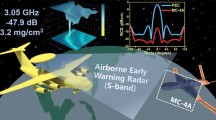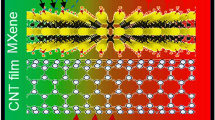Abstract
High efficiency and broad bandwidth wave absorption materials are urgent need in daily life for human health. Carbon material (graphene, etc.) is widely used in electromagnetic wave (EMW) absorption field for light weight, high surface area, and excellent electrical conductivity. However, the immoderate conductivity of the carbon will also cause the impedance mismatch and need more consideration. We have synthesized sucrose-derived carbon-based hybrid absorbers, and a series of Ni-based alloys (Ni, Fe–Ni, Co–Ni) are decorated on the surface of the carbon. Consequently, the Ni/C composite shows a maximum attenuation constant, and an ultra-broad wide effective bandwidth of 6.24 GHz with an optimal reflection loss (RL) value of − 20.5 dB located at thickness of only 1.7 mm. The Co–Ni/C composite has an improved impedance matching level, and shows the optimal RL of − 34.3 dB located at a thickness of 3.3 mm with an effective bandwidth of 4.24 GHz. The Fe–Ni/C composite shows an optimal RL among all the samples of − 42.3 dB located at a thickness of 5.7 mm with the effective bandwidth of 2.8 GHz. The Ni-based alloys decorated sucrose-derived carbon hybrid can be a proper candidate for microwave absorption as its light-weight outstanding EMW absorption property.
Graphical abstract
The Ni-based alloys decorated sucrose-derived carbon hybrid for microwave absorption







Similar content being viewed by others
References
Wang L, Guan Y, Qiu X, Zhu H, Pan S, Yu M, Zhang Q (2017) Efficient ferrite/Co/porous carbon microwave absorbing material based on ferrite@metal–organic framework. Chem Eng J 326:945–955. https://doi.org/10.1016/j.cej.2017.06.006
Sang G, Xu P, Yan T, Murugadoss V, Naik N, Ding Y et al (2021) Interface engineered microcellular magnetic conductive polyurethane nanocomposite foams for electromagnetic interference shielding. Micro Nano Lett 13(1):153. https://doi.org/10.1007/s40820-021-00677-5
Ma G, Yang M, Xiao S, Yang Z, Sheng P (2014) Acoustic metasurface with hybrid resonances. Nat Mater 13(9):873–878. https://doi.org/10.1038/nmat3994
Chen J, Zheng J, Huang Q, Wang F, Ji G (2021) Enhanced Microwave Absorbing Ability of Carbon Fibers with Embedded FeCo/CoFe2O4 Nanoparticles. ACS Appl Mater Interfaces 13(30):36182–36189. https://doi.org/10.1021/acsami.1c09430
Chen H, Huang Z, Huang Y, Zhang Y, Ge Z, Qin B et al (2017) Synergistically assembled MWCNT/graphene foam with highly efficient microwave absorption in both C and X bands. Carbon 124:506–514. https://doi.org/10.1016/j.carbon.2017.09.007
Zhang Y, Huang Y, Chen H, Huang Z, Yang Y, Xiao P et al (2016) Composition and structure control of ultralight graphene foam for high-performance microwave absorption. Carbon 105:438–447. https://doi.org/10.1016/j.carbon.2016.04.070
Li G, Xie T, Yang S, Jin J, Jiang J (2012) Microwave absorption enhancement of porous carbon fibers compared with carbon nanofibers. J Phys Chem C 116(16):9196–9201. https://doi.org/10.1021/jp300050u
Qi X, Yang Y, Zhong W, Deng Y, Au C, Du Y (2009) Large-scale synthesis, characterization and microwave absorption properties of carbon nanotubes of different helicities. J Solid State Chem 182(10):2691–2697. https://doi.org/10.1016/j.jssc.2009.07.036
Gonzalez M, Crespo M, Baselga J, Pozuelo J (2016) Carbon nanotube scaffolds with controlled porosity as electromagnetic absorbing materials in the gigahertz range. Nanoscale 8(20):10724–10730. https://doi.org/10.1039/c6nr02133f
Zhao T, Hou C, Zhang H, Zhu R, She S, Wang J et al (2014) Electromagnetic wave absor-bing properties of amorphous carbon nanotubes. Sci Rep 4:5619. https://doi.org/10.1038/srep05619
Li J, Xie Y, Lu W, Chou T-W (2018) Flexible electromagnetic wave absorbing composite ba-sed on 3D rGO-CNT-Fe3O4 ternary films. Carbon 129:76–84. https://doi.org/10.1016/j.carbon.2017.11.094
Munir A (2017) Microwave Radar Absorbing Properties of Multiwalled Carbon Nanotubes Polymer Composites: A Review. Adv Polym Technol 36(3):362–370. https://doi.org/10.1002/adv.21617
Meng F, Wang H, Huang F, Guo Y, Wang Z, Hui D et al (2018) Graphene-based microwave absorbing composites: a review and prospective. Compos B Eng 137:260–277. https://doi.org/10.1016/j.compositesb.2017.11.023
Lu S, Xia L, Xu J, Ding C, Li T, Yang H et al (2019) Permittivity-regulating strategy enabling superior electromagnetic wave absorption of lithium aluminum silicate/rGO nanocomposites. ACS Appl Mater Interfaces 11(20):18626–18636. https://doi.org/10.1021/acsami.9b00348
Feng J, Pu F, Li Z, Li X, Hu X, Bai J (2016) Interfacial interactions and synergistic effect of CoNi nanocrystals and nitrogen-doped graphene in a composite microwave absorber. Carbon 104:214–225. https://doi.org/10.1016/j.carbon.2016.04.006
Xu W, Wang G-S, Yin P-G (2018) Designed fabrication of reduced graphene oxides/Ni hybrids for effective electromagnetic absorption and shielding. Carbon 139:759–767. https://doi.org/10.1016/j.carbon.2018.07.044
Liu Q, Liu X, Feng H, Shui H, Yu R (2017) Metal organic framework-derived Fe/carbon p-orous composite with low Fe content for lightweight and highly efficient electromagn-etic wave absorber. Chem Eng J 314:320–327. https://doi.org/10.1016/j.cej.2016.11.089
Ma E, Li J, Zhao N, Liu E, He C, Shi C (2013) Preparation of reduced graphene oxide/Fe3O4 nanocomposite and its microwave electromagnetic properties. Mater Lett 91:209–212. https://doi.org/10.1016/j.matlet.2012.09.097
Wu N, Xu D, Wang Z, Wang F, Liu J, Liu W et al (2019) Achieving superior electromagnetic wave absorbers through the novel metal-organic frameworks derived magnetic porous carbon nanorods. Carbon 145:433–444. https://doi.org/10.1016/j.carbon.2019.01.028
Yue L, Zhong B, Xia L, Zhang T, Yu Y, Huang X (2021) Three-dimensional network-like structure formed by silicon coated carbon nanotubes for enhanced microwave absorption. J Colloid Interface Sci 582:177–186. https://doi.org/10.1016/j.jcis.2020.08.024
Du Y, Liu T, Yu B, Gao H, Xu P, Wang J et al (2012) The electromagnetic properties and microwave absorption of mesoporous carbon. Mater Chem Phys 135(2):884–891. https://doi.org/10.1016/j.matchemphys.2012.05.074
Liu T, Pang Y, Xie XB (2016) Kobayashi Satoru, Co/C nanoparticles with low graphitization degree: a high performance microwave-absorbing material. J Mater Chem C. https://doi.org/10.1039/C5TC03874J
Ma W, He P, Wang T, Xu J, Liu X, Zhuang Q et al (2021) Microwave absorption of carbonization temperature-dependent uniform yolk-shell H-Fe3O4@C microspheres. Chem Eng Sci 420. https://doi.org/10.1016/j.cej.2021.129875
Bommier C, Luo W, Gao W-Y, Greaney A, Ma S, Ji X (2014) Predicting capacity of hard carbon anodes in sodium-ion batteries using porosity measurements. Carbon 76:165–174. https://doi.org/10.1016/j.carbon.2014.04.064
Wang N, Hong Y, Liu TX, Wang Q, Huang J (2021) Sucrose derived microporous–mesoporous carbon for advanced lithium–sulfur batteries. Ceram Int 47(1):899–906. https://doi.org/10.1016/j.ceramint.2020.08.202
Takanabe K, Nagaoka K, Nariai K, Aika KI (2005) Titania-supported cobalt and nickel bimetallic catalysts for carbon dioxide reforming of methane. J Catal 232(2):268–275. https://doi.org/10.1016/j.jcat.2005.03.011
Sun H, Che R, You X, Jiang Y, Yang Z, Deng J et al (2014) Cross-stacking aligned carbon-nanotube films to tune microwave absorption frequencies and increase absorption intensities. Adv Mater 26(48):8120–8125. https://doi.org/10.1002/adma.201403735
Dresselhaus MS, Jorio A, Hofmann M, Dresselhaus G, Saito R (2010) Perspectives on carbon nanotubes and graphene Raman spectroscopy. Nano Lett 10(3):751–758. https://doi.org/10.1021/nl904286r
Pan L, Chortos A, Yu G, Wang Y, Isaacson S, Allen R et al (2014) An ultra-sensitive resistive pressure sensor based on hollow-sphere microstructure induced elasticity in conducting polymer film. Nat Commun 5:3002. https://doi.org/10.1038/ncomms4002
Wang L, Wen B, Bai X, Liu C, Yang H (2019) Facile and green approach to the synthesis of zeolitic imidazolate framework nanosheet-derived 2D Co/C composites for a lightweight and highly efficient microwave absorber. J Colloid Interface Sci 540:30–38. https://doi.org/10.1016/j.jcis.2018.12.111
Liu P, Zhang Y, Yan J, Huang Y, Xia L, Guang Z (2019) Synthesis of lightweight N-doped graphene foams with open reticular structure for high-efficiency electromagnetic wave absorption. Chem Eng J 368:285–298. https://doi.org/10.1016/j.cej.2019.02.193
Zhang H, Wang B, Feng A, Zhang N, Jia Z, Huang Z et al (2019) Mesoporous carbon hollow microspheres with tunable pore size and shell thickness as efficient electromagnetic wave absorbers. Compos B Eng 167:690–699. https://doi.org/10.1016/j.compositesb.2019.03.055
Li Z, Han X, Ma Y, Liu D, Wang Y, Xu P et al (2018) MOFs-derived hollow Co/C microspheres with enhanced microwave absorption performance. ACS Sustain Chem Eng 6(7):8904–8913. https://doi.org/10.1021/acssuschemeng.8b01270
Wu N, Liu C, Xu D, Liu J, Liu W, Liu H et al (2019) Ultrathin high-performance electromagnetic wave absorbers with facilely fabricated hierarchical porous Co/C crabapples. J Mater Chem C 7(6):1659–1669. https://doi.org/10.1039/C8TC04984J
Wei H, Zhang Z, Hussain G, Zhou L, Li Q, Ostrikov K (2020) Techniques to enhance magnetic permeability in microwave absorbing materials. Appl Mater Today 19:100596. https://doi.org/10.1016/j.apmt.2020.100596
Ma G, Xia L, Yang H, Wang X, Zhang T, Huang X et al (2021) Multifunctional lithium Aluminosilicate/CNT composite for gas filtration and electromagnetic wave absorption. Chem Eng J 418:129429. https://doi.org/10.1016/j.cej.2021.129429
Wu N, Lv H, Liu J, Liu Y, Wang S, Liu W (2016) Improved electromagnetic wave absorption of Co nanoparticles decorated carbon nanotubes derived from synergistic magnetic and dielectric losses. Phys Chem Chem Phys 18(46):31542–31550. https://doi.org/10.1039/C6CP06066H
Yang Y, Xia L, Zhang T, Shi B, Huang L, Zhong B et al (2018) Fe3O4@LAS/RGO compo-sites with a multiple transmission-absorption mechanism and enhanced electromagnetic wave absorption performance. Chem Eng J 352:510–518. https://doi.org/10.1016/j.cej.2018.07.064
Lou Z, Han H, Zhou M, Han J, Cai J, Huang C et al (2018) Synthesis of magnetic wood with excellent and tunable electromagnetic wave-absorbing properties by a facile vacuum/pressure impregnation method. ACS Sustain Chem Eng 6(1):1000–1008. https://doi.org/10.1021/acssuschemeng.7b03332
Zhan Y, Xia L, Yang H, Zhou N, Ma G, Zhang T et al (2021) Tunable electromagnetic wave absorbing properties of carbon nanotubes/carbon fiber composites synthesized direc-tly and rapidly via an innovative induction heating technique. Carbon 175:101–111. https://doi.org/10.1016/j.carbon.2020.12.080
Shi XL, Cao M-S, Yuan J, Fang X-Y (2009) Dual nonlinear dielectric resonance and nesting microwave absorption peaks of hollow cobalt nanochains composites with negative permeability. Appl Phys Lett 95(16):163108. https://doi.org/10.1063/1.3250170
Wu N, Lv H, Liu J, Liu Y, Wang S, Liu W (2016) Improved electromagnetic wave absorpt-ion of Co nanoparticles decorated carbon nanotubes derived from synergistic magnetic and dielectric losses. Phys Chem Chem Phys 18(46):31542–31550. https://doi.org/10.1039/c6cp06066h
Xie P, Liu Y, Feng M, Niu M, Liu C, Wu N et al (2021) Hierarchically porous Co/C nanocomposites for ultralight high-performance microwave absorption. Adv Compos Mater 4(1):173–185. https://doi.org/10.1007/s42114-020-00202-z
Liang L, Yang R, Han G, Feng Y, Zhao B, Zhang R et al (2020) Enhanced Electromagnetic Wave-Absorbing Performance of Magnetic Nanoparticles-Anchored 2D Ti3C2Tx MX-ene. ACS Appl Mater Interfaces 12(2):2644–2654. https://doi.org/10.1021/acsami.9b18504
Cao MS, Wang XX, Zhang M, Shu JC, Cao WQ, Yang H-J et al (2019) Electromagnetic Response and Energy Conversion for Functions and Devices in Low-Dimensional Materials. Adv Func Mater 29(25):1807398. https://doi.org/10.1002/adfm.201807398
Li T, Xia L, Yang H, Wang X, Zhang T, Huang X et al (2021) Construction of a Cu–Sn heterojunction interface derived from a Schottky junction in Cu@Sn/rGO composites as a highly efficient dielectric microwave absorber. ACS Appl Mater Interfaces 13(10):11911–11919. https://doi.org/10.1021/acsami.0c22049
Kong L, Yin X, Zhang Y, Yuan X, Li Q, Ye F et al (2013) Electromagnetic wave absorpt-ion properties of reduced graphene oxide modified by maghemite colloidal nanopa-rticle clusters. J Phys Chem C 117(38):19701–19711. https://doi.org/10.1021/jp4058498
Su Z, Tao J, Xiang J, Zhang Y, Su C, Wen F (2016) Structure evolution and microwave absorption properties of nickel nanoparticles incorporated carbon spheres. Mater Res Bull 84:445–448. https://doi.org/10.1016/j.materresbull.2016.08.036
Mao L, Zhang Y, Hu Y, Ho KH, Ke Q, Liu H et al (2015) Activation of sucrose-derived carbon spheres for high-performance supercapacitor electrodes. RSC Adv 5(12):9307–9313. https://doi.org/10.1039/C4RA11028E
Che RC, Peng L-M, Duan XF, Chen Q, Liang XL (2004) Microwave absorption enhancement and complex permittivity and permeability of Fe encapsulated within carbon nanotubes. Adv Mater 16(5):401–405. https://doi.org/10.1002/adma.200306460
Zhao S, Wang C, Su T, Zhong B (2019) One-step hydrothermal synthesis of Ni–Fe–P/graphene nanosheet composites with excellent electromagnetic wave absorption properties. RSC Adv 9(10):5570–5581. https://doi.org/10.1039/C9RA00085B
Qiu X, Wang L, Zhu H, Guan Y, Zhang Q (2017) Lightweight and efficient microwave absorbing materials based on walnut shell-derived nano-porous carbon. Nanoscale 9(22):7408–7418. https://doi.org/10.1039/C7NR02628E
Acknowledgements
The authors are grateful to the National Natural Science Foundation of China (Grant nos. 51302051 and 51872058), the Key Research and Development Program of Shandong Province (Nos. 2018JMRH0107 and 2019JMRH0402), Natural Science Foundation of Shandong (ZR2012EMQ 007), and Weihai supporting project for their financial support.
Author information
Authors and Affiliations
Corresponding authors
Ethics declarations
Conflict of interest
The authors declare that they have no conflict of interests.
Additional information
Publisher's Note
Springer Nature remains neutral with regard to jurisdictional claims in published maps and institutional affiliations.
Supplementary Information
Below is the link to the electronic supplementary material.
Rights and permissions
About this article
Cite this article
Wu, X., Liu, K., Ding, J. et al. Construction of Ni-based alloys decorated sucrose-derived carbon hybrid towards: effective microwave absorption application. Adv Compos Hybrid Mater 5, 2260–2270 (2022). https://doi.org/10.1007/s42114-021-00383-1
Received:
Revised:
Accepted:
Published:
Issue Date:
DOI: https://doi.org/10.1007/s42114-021-00383-1




